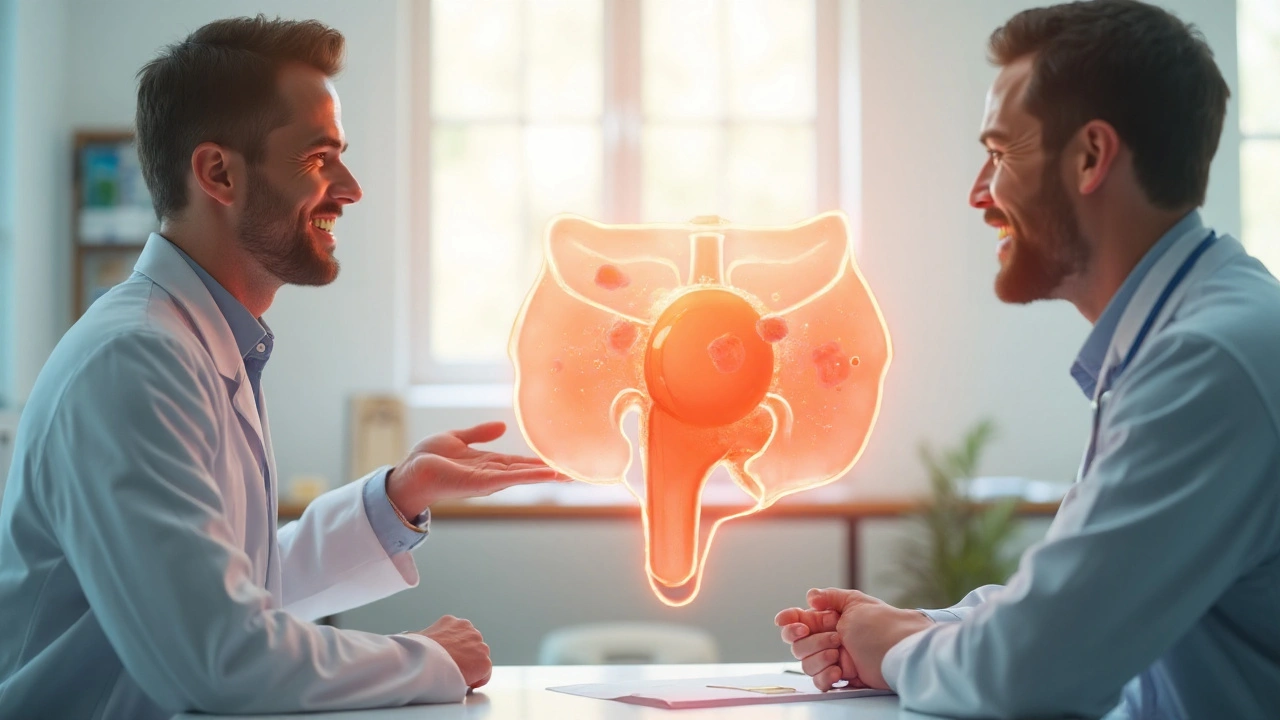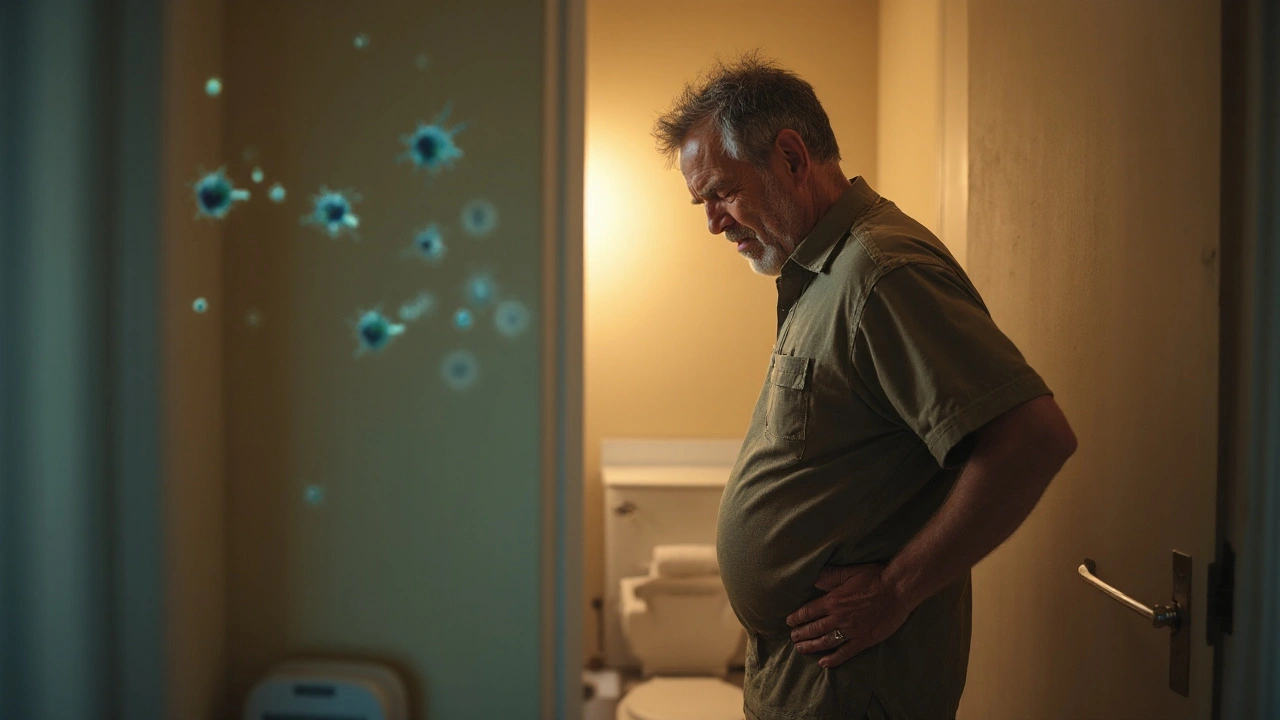Benign Prostatic Hyperplasia is a non‑cancerous enlargement of the prostate gland that commonly affects men over 50. As the gland swells, it compresses the urethra, leading to a range of lower urinary tract symptoms (LUTS). When urine can’t flow freely, it often pools in the bladder, creating a perfect breeding ground for urinary tract infections (UTIs). This article untangles that connection, shows how to recognize the overlap, and offers clear actions to keep both problems at bay.
Quick Takeaways
- Enlarged prostate narrows the urethra, causing incomplete emptying and residual urine.
- Stagnant urine is a prime fuel for bacteria, especially Escherichia coli, the leading UTI culprit.
- Symptoms that overlap include frequent urges, nocturia, and a weak stream - watch for fever or foul‑smelling urine as infection signs.
- Routine checks like residual urine volume and the International Prostate Symptom Score (IPSS) help spot risk early.
- Combined management - lifestyle tweaks, meds, and proper hygiene - reduces infection rates dramatically.
Understanding BPH and Its Typical Symptoms
When the prostate grows, it squeezes the urethra, a tube that carries urine out of the bladder. The most common lower urinary tract symptoms (LUTS) fall into two groups:
- Storage symptoms: urgency, frequency, nocturia (waking up to pee), and sudden urges.
- Voiding symptoms: weak stream, hesitancy, dribbling, and a sensation of incomplete emptying.
Doctors often quantify severity with the International Prostate Symptom Score (IPSS), a questionnaire that scores each symptom from 0 (none) to 5 (severe). A total above 8 usually indicates clinically relevant BPH.
Why Stagnant Urine Sparks Infections
The bladder is designed to flush out bacteria every time you void. BPH‑induced obstruction leaves residual urine volume of 50ml or more, and that stagnant pool becomes a buffet for microbes. Most community‑acquired UTIs in men are caused by Escherichia coli, but other gram‑negative rods, Enterococcus, and even fungi can take hold when defenses are lowered.
Two physiological mechanisms amplify risk:
- Mechanical irritation: The swollen prostate irritates the bladder neck, causing inflammation (prostatitis‑like changes) that weakens the bladder’s antimicrobial lining.
- Immune compromise: Older men often have reduced urinary IgA and altered cytokine profiles, making it harder to clear bacteria.
How to Spot the Overlap - Symptoms That Signal an Infection
While LUTS are common in pure BPH, an infection adds distinct red‑flags:
- Fever or chills.
- Painful urination (dysuria) and suprapubic tenderness.
- Cloudy, foul‑smelling, or bloody urine.
- Sudden worsening of urgency or nocturia after a period of stability.
If any of these appear, a urine culture is warranted. A positive culture (>10⁵CFU/ml) confirms a UTI, guiding antibiotic choice.
Diagnosing the Double Trouble
Clinicians combine symptom scores, imaging, and lab tests:
- IPSS questionnaire - establishes baseline BPH severity.
- Post‑void residual (PVR) ultrasound - quantifies urine left after voiding; >100ml often triggers further work‑up.
- Urinalysis and culture - detect infection, white cells, and specific pathogens.
- Prostate‑specific antigen (PSA) - helps rule out cancer when PSA is elevated.
When both PVR is high and a culture is positive, the treatment plan must address obstruction and infection simultaneously.
Comparison: BPH vs. Prostatitis
| Aspect | BPH | Prostatitis |
|---|---|---|
| Typical Cause | Age‑related hormonal change leading to glandular overgrowth | Bacterial infection or chronic inflammatory process |
| Primary Symptoms | Storage & voiding LUTS, gradually worsening | Painful urination, perineal pain, fever |
| Diagnostic Test | IPSS, PVR ultrasound, PSA | Urine & semen culture, MRI for chronic cases |
| First‑line Treatment | Alpha‑blockers, 5‑α‑reductase inhibitors | Targeted antibiotics, anti‑inflammatories |

Managing BPH to Prevent UTIs
Effective BPH control reduces urine stasis, the main infection driver. Strategies fall into three buckets:
- Medication:
• Alpha‑blockers (e.g., tamsulosin) relax smooth muscle, improving flow.
• 5‑α‑reductase inhibitors (e.g., finasteride) shrink prostate size over months. - Lifestyle tweaks: limit caffeine and alcohol, double‑water intake early in the day, practice timed voiding to train the bladder.
- Procedural options: Transurethral resection of the prostate (TURP) or newer laser enucleation for severe obstruction.
When residual urine stays high despite meds, intermittent self‑catheterization can temporarily clear the bladder and break the bacterial cycle.
Treating the Infection When It Strikes
Prompt, culture‑guided antibiotics are the backbone. Common first‑line agents include:
- Ciprofloxacin - excellent gram‑negative coverage, but watch for rising resistance.
- Trimethoprim‑sulfamethoxazole - effective unless local resistance exceeds 20%.
For patients with recurring UTIs, a short course of prophylactic antibiotics or a single‑dose post‑void diphosphate (D‑mannose) supplement can help, although data are mixed. Always balance benefits against the risk of antibiotic resistance.
When to Seek Immediate Care
If any of these appear, call a doctor right away:
- High fever (>38°C) or shaking chills.
- Severe flank pain suggesting kidney involvement.
- Inability to pass urine (acute urinary retention).
- Persistent symptoms despite a full course of antibiotics.
Acute retention may require a temporary catheter, while kidney‑related pain could signal a pyelonephritis that needs IV therapy.
Related Topics to Explore
Understanding the BPH‑UTI link opens doors to several adjacent subjects. Readers often ask about:
- How prostate‑specific antigen (PSA) trends differ between BPH and prostate cancer.
- The role of chronic kidney disease (CKD) when untreated UTIs repeatedly damage the kidneys.
- Dietary approaches - like cranberry extract or zinc - that may reduce bacterial adhesion.
- Emerging minimally invasive BPH therapies such as prostatic urethral lift (Urolift).
These topics form a natural progression: first master symptom control, then dive deeper into prevention, and finally explore advanced interventions.
Bottom Line
While BPH itself isn’t an infection, its hallmark-restricted urine flow-creates a low‑grade environment where bacteria thrive. Spotting the subtle shift from routine LUTS to true infection, measuring residual urine, and pairing appropriate meds with smart hygiene can keep both the prostate and the urinary tract healthy.
Frequently Asked Questions
Can BPH cause a UTI on its own?
BPH doesn’t introduce bacteria, but the obstruction it creates leads to urine stasis, which is a major risk factor for UTIs. So the link is indirect but clinically important.
What level of post‑void residual volume is worrisome?
A residual volume above 50ml is considered abnormal, and >100ml signals a high infection risk that warrants further evaluation.
Are alpha‑blockers enough to stop infections?
Alpha‑blockers improve flow but don’t shrink the gland. For many men, combining them with a 5‑α‑reductase inhibitor or a surgical option reduces residual urine enough to lower infection rates.
How long should antibiotics be taken for a BPH‑related UTI?
Typically 7‑10days, guided by culture results. Longer courses are reserved for complicated cases, such as when kidney involvement is suspected.
Is catheter use dangerous for BPH patients?
Temporary catheterization is safe when done under sterile conditions. Prolonged use can introduce new bacteria, so it should be limited to the shortest duration needed.
Can lifestyle changes alone prevent UTIs for men with BPH?
Good habits-regular timed voiding, adequate hydration, reduced caffeine, and proper perineal hygiene-significantly lower risk, though many still need medical therapy for optimal control.
When is surgery the right choice for BPH?
Surgery is considered when medication fails to relieve high post‑void residuals, severe LUTS impair quality of life, or repeated UTIs occur despite best medical management.



Enough with the sugar‑coated fluff – BPH won’t fix itself unless you actually empty your bladder.
Yo, that rundown is spot on. I’ve seen guys in their 60s swear by timed voids and cutting back on late‑night coffee. It’s crazy how a simple habit tweak can shave off that residual urine volume. Keep the info coming!
Great summary! Remember to stay hydrated but not too much before bed.
The relationship between prostatic enlargement and urinary infection is underpinned by well‑documented physiological mechanisms.
First, the mechanical obstruction caused by a hypertrophic gland leads to incomplete bladder emptying, creating a post‑void residual that serves as a bacterial reservoir.
Second, the chronic irritation of the bladder neck alters the mucosal defenses, reducing the secretion of protective IgA and antimicrobial peptides.
Third, age‑related changes in the immune system decrease the ability of local leukocytes to respond swiftly to invading pathogens.
As a result, even low‑grade bacteriuria can progress to a symptomatic infection in the presence of a favorable environment.
Clinical studies have consistently shown that residual volumes above 50 ml are associated with a higher incidence of uropathogenic Escherichia coli colonisation.
When the volume exceeds 100 ml, the risk escalates dramatically, often necessitating further urological evaluation.
The International Prostate Symptom Score remains a valuable tool for quantifying the severity of LUTS and identifying patients who may benefit from earlier imaging.
Ultrasonographic measurement of post‑void residual is inexpensive, non‑invasive, and provides immediate data for therapeutic decision‑making.
Pharmacologically, alpha‑blockers improve urinary flow but do not address the underlying glandular size, which is why combination therapy with a 5‑α‑reductase inhibitor is frequently recommended for men with significant prostate volumes.
In patients who fail medical management, minimally invasive procedures such as Urolift or laser enucleation can achieve rapid reduction in obstruction and residual urine.
Importantly, any antimicrobial regimen should be guided by urine culture to avoid unnecessary broad‑spectrum exposure and to curb rising resistance rates.
For recurrent infections, a short course of prophylactic antibiotics may be considered, yet clinicians must weigh the benefits against the potential for Clostridioides difficile and other complications.
Lifestyle adjustments-limiting caffeine, scheduling regular voids, and practising perineal hygiene-provide a low‑cost adjunct that can markedly lower infection rates.
Ultimately, a comprehensive approach that integrates symptom scoring, imaging, targeted pharmacotherapy, and patient education offers the best chance of preventing the vicious cycle of BPH‑related urinary tract infections.
Oh great, another miracle pill that’ll magically clear your bladder – sure, Jan. 🙄
Thank you for the thorough overview. In practice, I recommend starting with an alpha‑blocker, assessing residual volume after two weeks, and then adding a 5‑α‑reductase inhibitor if the PVR remains high.
Alas, the saga continues! The theater of “miracle cures” never fails to amuse, yet we must not forget that patience and proper urethral care are the true protagonists.
I appreciate the depth of information presented here. It is reassuring to see that both medical and lifestyle strategies are emphasized, offering patients a balanced path to recovery.
Indeed, the integration of simple habits such as timed voiding and adequate hydration can complement pharmacological treatments effectively.
Building on your kind words, I would suggest patients maintain a symptom diary; tracking frequency and nocturia can help clinicians fine‑tune therapy and catch infections early.